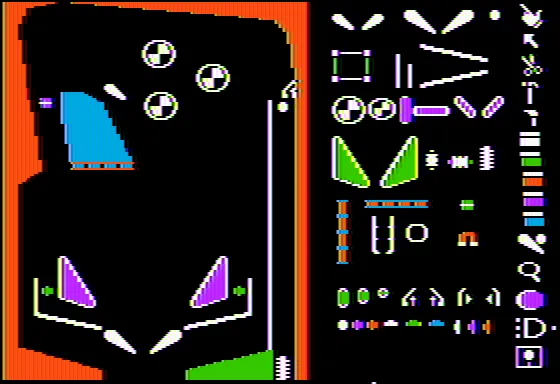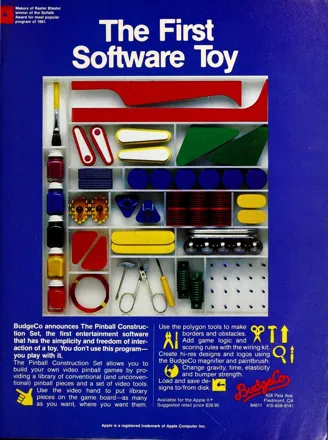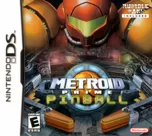Pinball Construction Set
Description official descriptions
Pinball Construction Set is considered the first construction set game that launched the concept and genre.
Construct a pinball game by dropping parts onto the table (or alter the table itself). Alter world physics like gravity, bounce, kick, and speed. Paint custom backboards. Wire together targets for specials and bonus points. Finally, save creations for later, or generate a self-loading version of the table to distribute to friends (original program not needed to play).
Spellings
- ピンボール・コンストラクション・セット - Japanese spelling
Groups +
Screenshots
Promos
Credits (Apple II version)
9 People (3 developers, 6 thanks)
| By | |
| Thanks to |
|
| Graphics |
|
| Photo |
|
Reviews
Critics
Average score: 92% (based on 6 ratings)
Players
Average score: 3.8 out of 5 (based on 28 ratings with 0 reviews)
Be the first to review this game!
Trivia
Bug
An unfortunate bug exists in the PC version: Once you reach a certain amount of objects on the table and/or "painting" on the table and backboard, you can't save your work and reliably read it back. (You can still generate a finished stand-alone table, but stand-alone tables don't read back into the program for editing the same way editor files do.) A partial workaround is to maintain revisions of your table in different save files, so that you can go back in time to some point in your table's development if necessary to fix it. Another workaround is to not paint on the table or backglass at all until the table is completely finished, since excessive painting seems to trigger the bug the most.
Development
Originally, the game was released for Apple II by Bill Budge's own publishing company, "BudgeCo" and featured different packaging artwork that depicted loose components of 'pinball table' (flippers, silver balls, colored paints, etc) in a large plastic tray. At a later stage, he joined Electronic Arts who went on to publish it and repackaged with different cover art in a familiar square format similar to other EA releases of the time.
Interview
The inside tri-fold has a interview with Bill Budge. The following is the text of that interview (look for the dated references, like a description of what Icons are):
Bill Budge is about to sit for the photo you see below. There are video games here and he’s playing one to kill time. You’d think he’d be really good. He's okay.
Black alien ships pursue him, he dodges beams of light. And suddenly, the grown-up kid genius, a guy who changed what we could expect from our home computers, who would rather program than sleep or do anything else for that matter, gets annihilated by a blind-side fireball.
"I got blasted." He says this very softly, philosophically even. Here is a man who understands what it feels like at the other end of the program.
What is a construction set? Why would you want one? Budge thinks about things like this. After all, the world is a construction set of sorts.
You grab this and you add that and you make stuff. In a sense, Budge is just taking this process to a certain point and passing it on. He’s sculpting this beam of electrons, putting them through the arcane phases of machine language and then handing them to you in the more familiar forms of screwdrivers, hammers, and magnifying glasses.
Icons, he calls them. They’re symbols. Not just symbols for things in the world, but placeholders for the vast hunks of programming behind it all. They make the game accessible, make it feel like a construction set: Move the flippers here. Put a bumper in the mouth of that corridor.
Then shoot a ball through and wonder. With each flicker of light, waves of Budge code flood thIs way and that. Logic gates traffic bits by the thousands. You don't see it. You don't want to see it. You don't have to see it.
Budge smiles. "In a way, I’m just saving you a lot of time. You can read the manual for a few minutes, go over to the parts box, and get started. Right away, it works. You're doing it. That's what makes this thing a toy."
The Magnifying Glass. "The whole game started here. There was nothing else. No pinball. Nothing. Just this thing that magnified parts of a video screen."
The World Functions. "You can move these little rheostats and change the way the world works. That’s something software can do. It’s a way of getting control you don’t otherwise have."
The Logic Diagram. "This is like being underneath the board, looking up at the wiring. You want to change the scoring or the music, you get your screwdriver and pliers and you come down here."
Master Blaster. "I sat down and built this in about half an hour. You could make a better one if you spent the time. Maybe."
The Three-Ball Stacker. "Maybe the most complicated piece in the game. It makes for a neat madness, catching halls until there are three in there, then cutting them all loose at once. If I had left this piece out, I would have saved myself a lot of work."
The Bumper. "There are six of these. which doesn’t sound like a lot until you try them all and watch things go out of control."
The Paintbrush. "It makes drawing things easy. It also turned out to be a pretty good primer about how colors work on these machines."
The Hammer. "Drives nails that you use to pull the board into different shapes. Originally, I tried a crowbar for this, but you could never make out what the thing was supposed to be.
References
One of the four large meeting rooms on the first floor of the "Mission Control" building of Electronic Arts Redwood City, CA campus is named Pinball Construction Set. The four meeting rooms are named after EA's first four games.
Awards
- Computer Gaming World
- November 1996 (15th anniversary issue) – #50 on the "150 Best Games of All Time" list
- November 1996 (15th anniversary issue) – Most Innovative Computer Game
Information also contributed by Garcia Indra was here, nullnullnull and PCGamer77
Analytics
Upgrade to MobyPro to view research rankings and price history! (when applicable)
Identifiers +
Contribute
Are you familiar with this game? Help document and preserve this entry in video game history! If your contribution is approved, you will earn points and be credited as a contributor.
Contributors to this Entry
Game added by Trixter.
Commodore 64 added by tbuteler. PC-98, Atari 8-bit, PC-88, Apple II added by Terok Nor. Macintosh added by Garcia.
Additional contributors: Garcia, Patrick Bregger, Rik Hideto.
Game added August 28, 1999. Last modified July 6, 2024.


















